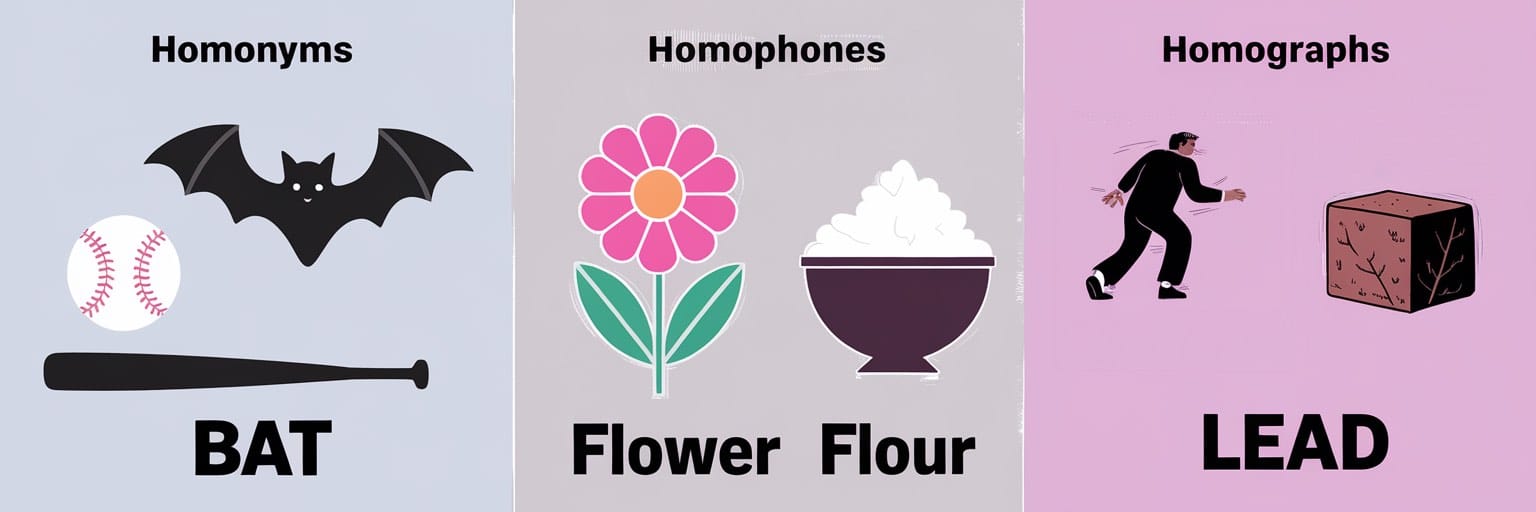The English language contains a wealth of words whose forms hide multiple meanings. This article examines words that look or sound the same yet convey distinct concepts. By analyzing these terms, we can appreciate the versatility of English and improve the precision of our speech and writing.
What are homonyms?
Homonyms are words that share either the same spelling or the same pronunciation while representing different meanings. They split into two groups: one group comprises words that sound alike but may differ in spelling, and the other includes words written identically though their meanings—and sometimes their pronunciations—vary. For example, consider the word bat. It may refer to a nocturnal animal or a piece of sports equipment. Such dualities add a playful twist to communication and can lead to both humorous misunderstandings and clever puns.
Examples of Homonyms
A few words illustrate the concept clearly. The term bark may denote the sound made by a dog or the protective outer covering of a tree. Similarly, tear can indicate either the act of ripping or a drop of liquid from the eye. Even though these words are spelled the same, the intended meaning shifts entirely with context. Such cases demonstrate how one written form can open up multiple interpretations during conversation and composition.
Homonyms in Language Use
Writers and speakers often take advantage of homonyms to inject wit into their expressions. The same word used in different settings might create amusing ambiguities or subtle double meanings. However, for individuals mastering English, distinguishing which meaning is intended relies heavily on contextual clues. By carefully examining surrounding words, one can determine whether a term like lead functions as a verb meaning “to guide” or refers to a metallic element.
What are homophones?
Homophones are words that sound the same even though their spellings and meanings differ. The words flour and flower serve as a typical example: pronounced identically, one names an ingredient for baking while the other names a plant structure. This similarity in sound, coupled with differences in spelling, frequently leads to playful language experiments and occasional mix-ups.
Examples of Homophones
English offers many instances of homophones. Consider the pair fair and fare. The first might indicate an event or describe equity, while the second typically relates to a cost charged for a service such as transportation. Another well-known pair is knight and night, where one evokes images of medieval warriors and the other describes a period of darkness. Even everyday groups like their, there, and they’re remind us that identical pronunciation does not guarantee identical meaning or spelling.
Homophones in Language Use
Homophones present both opportunities and challenges. They enable playful wordplay and the crafting of clever puns. At the same time, the risk of confusion in writing and speaking is ever-present. For language students, careful attention to context is key when deciding among similarly pronounced words. Successful use of homophones in conversation and composition demands an awareness of the subtle distinctions that separate them.
Understanding Homographs
Homographs are words that share identical spelling while holding different meanings. In some instances, they also differ in pronunciation. The word lead offers a clear example: pronounced one way, it means to guide; pronounced another, it signifies a heavy metal.
When a written word carries more than one possible pronunciation, these are sometimes known as heteronyms. Even when homographs maintain the same sound, as in the case of bark (whether referring to a tree’s covering or a dog’s sound), the correct interpretation depends entirely on context.
Pronunciation Variants Among Homographs
Differences in pronunciation add an extra dimension to homographs. Take tear once more: when spoken as “teer,” it denotes a droplet from the eye; when pronounced “tare,” it means to rip apart. Such variations compel speakers to rely on situational cues. In contrast, homographs that do not change their sound—like bark—challenge us to extract meaning solely from the surrounding words.
Key Differences Among Homonyms, Homophones, and Homographs
While homonyms cover all words that share form yet differ in meaning, homophones and homographs represent specific instances of this broader category. Homophones focus solely on identical pronunciation despite differences in spelling, whereas homographs concentrate on identical spelling, with pronunciation sometimes varying. For example, the trio to, too, and two illustrates the intricacies involved: despite sounding identical, each term carries its own distinct definition and usage.
At the highest level, homonyms form an umbrella category that includes all words sharing a common form (whether in spelling or sound) but differing in meaning. Within this broad group, two distinct subcategories emerge based on the primary characteristic used to group them:
- Homophones:
- Scope: Defined exclusively by identical pronunciation.
- Characteristics: Their spoken form is the same, even though their spellings and meanings diverge.
- Example: Flour and flower sound alike but are written differently and represent different things.
- Homographs:
- Scope: Defined by identical spelling.
- Characteristics: They share the same written form, though their pronunciations can either match or differ depending on context.
- Example: Lead may refer to guiding (pronounced /liːd/) or to a heavy metal (pronounced /lɛd/).
This hierarchical view clarifies that while every homophone and homograph is a homonym, each occupies a narrower niche determined by either its auditory or visual identity. Recognizing these distinctions is vital for selecting the right word based on whether pronunciation or spelling is the focal point.
The Role of These Words in Communication and Learning
Words that share form but not meaning enrich language by offering varied ways to express ideas. They create opportunities for clever phrasing and can occasionally lead to humorous or ambiguous results if misapplied. For those studying English, mastering these words contributes to improved clarity in both writing and speaking. Regular practice with these terms strengthens the skill of discerning subtle differences, ultimately leading to more precise communication.
Memory Aids for Differentiation
A practical method for keeping these word types straight is to associate each with its typical context. For words that sound the same but are spelled differently—such as bear and bare—link each to its specific meaning. For words that share spelling but differ in meaning, like lead, practice writing sentences that clarify each usage. Over time, this technique sharpens one’s ability to select the appropriate word form without hesitation.
A firm grasp of homonyms, homophones, and homographs enhances both communication and creative expression. While each word type presents its own set of challenges, careful attention to context and deliberate practice can ensure accurate usage. The clever interplay of words that share forms yet diverge in meaning not only enriches everyday exchanges but also provides endless opportunities for playful language exploration. Embracing these intricacies can transform the way one uses and appreciates English.
Further Reading
homonym vs. homophone vs. homograph by vocabulary.com
Over 300 Homonyms, Homophones, and Homographs by Richard Nordquist, ThoughtCo.
Homophones, homographs, and homonyms (…oh, my!) on Reddit
Homonyms, Homophones & Homographs by EasyTeaching, YouTube




